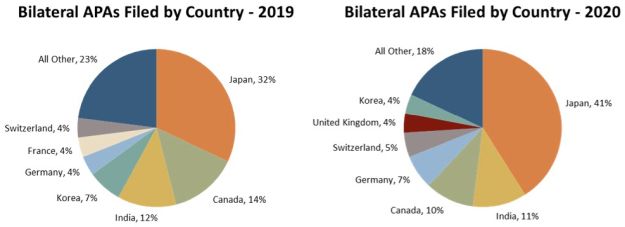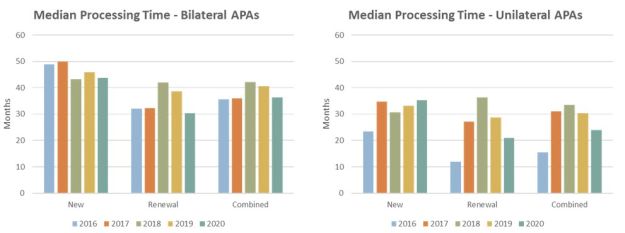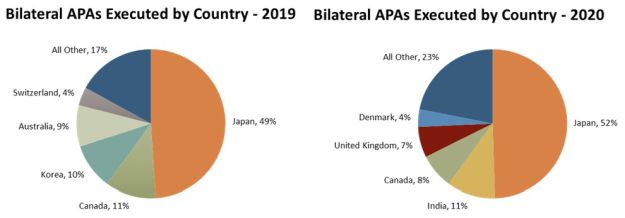Executive Summary
Our International Tax Group analyzes the report on the IRS's Advance Pricing and Mutual Agreement Program and identifies important insights and trends for advance pricing agreements.
- Effects of the COVID-19 pandemic on APMA operations and staffing
- APA demand and output, 2019 – 2020
- More challenges on the horizon
On March 23, 2021, the IRS issued its Announcement and Report Concerning Advance Pricing Agreements (2020 APA Report), which presents the key results of the IRS's Advance Pricing and Mutual Agreement Program (APMA). The 2020 APA Report provides general information about the operation of the program, including staffing, and statistical information about the numbers of APA applications received and resolved during the year, including countries involved, demographics of companies involved, industries covered, and transfer pricing methods (TPMs) employed.
While much of the data in the 2020 APA Report represents a snapshot in time, we can identify important trends based on such data and our experience advising companies pursuing and executing APAs. First, the data and our experience indicate that, in a challenging and unusual year, APMA performed relatively well compared with prior years and improved certain important metrics as it worked with treaty partners that also experienced significant COVID-19 obstacles. For example, APMA staffing increased approximately 27% from 2019, and such increase appears to have contributed, at least in part, to some of the largest improvements in APA processing times, including a 23% decrease in the time required to execute renewal APAs compared with 2019.
Second, in 2020, APMA executed the highest number of renewal APAs (75) since 2013 and the highest number of bilateral renewal APAs (64) in the program's history. Although the inventory of pending renewal APAs remains high at 187 (approximately 42% of total pending APAs) and the overall time to obtain an APA remains lengthy, a continued favorable trajectory should permit APMA to work through the backlog and reduce processing times.
Third, our experience indicates that companies with robust proposed TPMs that effectively address arm's-length returns for nonroutine intangibles and COVID-19 should see their APAs progress more efficiently than APAs with proposed TPMs that arguably require significant modifications (e.g., due to concerns raised by data from APMA's Functional Cost Diagnostic Model).
Finally, although not discussed in the 2020 APA Report, APMA has indicated that addressing the impact of COVID-19 on an APA requires careful analysis of each company's situation. The OECD Guidance on the Transfer Pricing Implications of the COVID-19 Pandemic provides helpful information, and in our experience, each company's specific facts (e.g., industry, market conditions, projections, results, APA term) must be evaluated to formulate a constructive solution for proposal to APMA.
APMA Operations and Staffing
The 2020 APA Report shows that, despite the numerous challenges and disruptions caused by the COVID-19 pandemic, APMA was able to adapt and continue on a positive trajectory. The IRS, including APMA, adapted to the new realities caused by the pandemic by embracing technology. APMA was able to conduct taxpayer meetings via video conferencing platforms rather than through in-person meetings. The U.S. competent authority has continued to negotiate APAs with treaty partners despite widespread travel restrictions, although it has not been able to reap the benefits of in-person negotiations, and the time allocated to each round of virtual negotiations has been significantly curtailed. Despite the pandemic, APMA executed more APAs in 2020 than in 2019 and reduced the median APA processing time.
Importantly, APMA's staffing resources increased more than 25% in 2020. The total number of APMA employees increased from 77 professionals at the end of 2019 to 98 professionals at the end of 2020. At the end of 2020, APMA had 64 team leaders (increased from 52 at the end of 2019), 21 economists (increased from 16 at the end of 2019), 9 managers (increased from 6 at the end of 2019), and 3 assistant directors (unchanged from 2019). Each assistant director oversees three managers who lead teams composed of both team leaders and economists.
Rev. Proc. 2015-41 continues to serve as the main source of IRS guidance on the APA process. In October 2020, APMA director John Hughes stated that APMA is carefully monitoring whether the requirements established by Rev. Proc. 2015-41 are serving the intended purpose but declined to provide a timeline for updated guidance. Hughes said the goal of including a long list of required information as part of an APA submission was to streamline the process of gathering documents that would likely be requested eventually, but noted that APMA is considering the utility of specific items that are requested. Taxpayers should benefit from APMA's continuing efforts to tailor the information required upfront to include only relevant and useful items.
While APMA has not released formal guidance on the pandemic's effects on APAs, public statements made by APMA professionals have indicated that it is APMA's preference to take a case-by-case approach. Notably, while speaking at a virtual conference in March 2021, Hughes advised taxpayers with APAs to avoid raising COVID-19-related issues with APMA prematurely and also suggested that taxpayers should avoid taking steps that complicate bilateral competent authority negotiations. The OECD's December 2020 COVID-19 guidance contains useful information to evaluate how TPMs can be modified to address the pandemic in a manner aligned with APMA's thinking on the topic.
APA Demand and Output
Number of new applications remained unchanged
In 2020, 121 APA applications were filed, unchanged from 2019. This indicates that company demand for APAs remained consistent despite the uncertainty caused by the pandemic. The country-by-country breakdown of bilateral filings also remained fairly consistent. As shown in the charts below, the number of bilateral filings involving Japan, India, and Canada represented 62% of all bilateral filings. The percentage of filings involving Germany, Korea, the United Kingdom, and Switzerland were specifically represented, with each constituting 4% to 7% of bilateral filings. No separate information on bilateral filings involving France was provided (unlike in 2019), implying a relatively low number of filings for that jurisdiction given APMA's approach of not providing data for categories involving fewer than three APAs.

Processing time and pending APAs
Despite the pandemic, the median time required to complete an APA continued to decrease in 2020 to 32.7 months (from 38.8 months in 2019 and 40.2 months in 2018). This decrease was driven largely by the substantial decrease in processing times for renewal bilateral and unilateral APAs. The processing times for new unilateral APAs unfortunately increased from 2018 to 2020.

The number of pending APAs remained consistent from 2019 to 2020. At the end of 2020, 448 APA requests were pending (384 bilateral, 21 multilateral, and 43 unilateral), down from 454 at the end 2019 (386 bilateral, 22 multilateral, and 46 unilateral). As in past years, the number of pending bilateral APAs was still high and far outnumbered the multilateral and unilateral APAs, indicating that APMA continues to face obstacles processing bilateral APAs. APMA has successfully decreased its inventory of pending unilateral APAs to its lowest number in more than a decade, and with the growing demand for multilateral APAs, the unilateral APA inventory in 2020 (43) was "only" double the multilateral APA inventory (21). In comparison, the unilateral APA inventory was 10 times that of the multilateral APA inventory in 2014. Japan (25%), India (20%), Canada (11%), and Germany (10%) constituted the majority of the pending bilateral APAs, consistent with past years. Numbers of pending APAs involving Korea, Mexico, Italy, and the United Kingdom were also indicated in the 2020 APA Report.
Executed APAs
The IRS executed more APAs in 2020 than in 2019 (127 compared with 120). The percentage of executed APAs that were renewals was consistent (59% in 2020 and 57% in 2019). There was an increase in the percentage of executed APAs that were bilateral in 2020 (83%) compared with 2019 (76%).
As in past years, the 2020 APA Report indicates that U.S.-Japan bilateral APAs continued to constitute the largest percentage of overall APAs that the program processed (52%), followed by India (11%), Canada (8%), the United Kingdom (7%), and Denmark (4%). The large number of bilateral APAs executed involving Japan can be attributed to the long history of the APA programs in the United States and Japan. In 2020, India was second only to Japan in terms of bilateral APA requests filed, pending bilateral APAs, and executed bilateral APAs, which reflects the fact that the U.S.-India APA volume continues to grow.

Withdrawn APA requests
Despite the pandemic, the number of APA applications withdrawn in 2020 decreased from 12 in 2019 to 7 in 2020, and no APAs were revoked or canceled in 2020.
U.S. vs. Non-U.S. parent companies
Similar to past years, the majority of APAs involved non-U.S. parent companies: 61% of the executed APAs for 2020 were for non-U.S. parent companies and their U.S. subsidiaries, while 27% involved U.S. parent companies and their non-U.S. subsidiaries. The ongoing appeal of the APMA program to non-U.S. parent companies, particularly Japanese parent companies, could be due to, among other things, the IRS's continued focus on transfer pricing involving non-U.S. parent companies, non-U.S. parent companies' desire for transfer pricing certainty, or an increase in audit activity in other countries for which resolution through a bilateral APA with the United States may be preferred.
Industries represented
As in 2019, most of the APAs executed in 2020 mainly involved manufacturing, with the next most common being wholesale/retail trade and then services. APAs were also executed in the management industry as well as the finance, insurance, and real estate industry category. Within the manufacturing segment, the transportation equipment, chemical, and miscellaneous manufacturing industries were relatively equally represented, followed by food, computer and electronic products, machinery, and plastics and rubber products manufacturing. To some extent, the year-over-year industry breakdown is random, providing a snapshot of a particular 12-month period, and many factors can impact the resolution timing for specific cases. The other industry classification that is prominent in the APA program is wholesale/retail trade, and merchant wholesalers of durable goods dominate that class year after year.
TPMs applied
For 2020, the comparable profits method/transactional net margin method (CPM/TNMM) continued to be the most commonly applied TPM for tangible and intangible property transactions (applied to 84% of such transactions). Of the profit level indicators (PLI) used when the CPM/TNMM is employed, the operating margin (defined as operating profit divided by net sales) was applied 69% of the time. Similar to past years, the CPM/TNMM was applied in 85% of the APAs with intercompany service transactions, and the most commonly selected PLI with the CPM/TNMM was the operating margin, used 57% of the time. Based on our experience, increased focus by APMA and other tax authorities on nonroutine intangibles, including marketing intangibles, may lead to a shift in the types of TPMs going forward.
APA terms
Rev. Proc. 2015-41 instructs taxpayers to request a term of at least five prospective years, and taxpayers may also request that the APA be "rolled back" to cover one or more earlier taxable years. APA term lengths, including rollback years, averaged six years in 2020 (same as in 2019). The largest number of APAs were executed with five-year terms (48% of the total), and 91% had terms of five to nine years. In 2020, the longest APA term was 14 years (only one APA had a 14-year term), compared with 15 years in 2019. A substantial number of the APAs with terms of greater than five years were submitted as a request for a five-year term, and the additional years were agreed to between the taxpayer and the IRS (or between the IRS and the foreign government, upon the taxpayer's request, in the case of a bilateral APA) to ensure a reasonable amount of prospectivity in the APA term. Interestingly, of the APAs executed in 2020, only 11% included rollback years, compared with 25% of the APAs executed in 2019. Also, companies with APA terms spanning years before and after the effective date of the Tax Cuts and Jobs Act of 2017 should take into account any implications from APMA's announcement, "Implementation of Competent Authority Resolutions," which addresses "telescoping" and other related topics.
FX adjustments
APMA does not have a set policy for adjustments to company financials to account for currency fluctuations. As in past years, the 2020 APA Report notes that "[i]n appropriate cases, APAs may provide specific approaches for dealing with risks, including currency risk, such as adjustment mechanisms and/or critical assumptions." Over the years of the APA program, FX-adjustment mechanisms have been proposed by companies and by governments, and when the fluctuations are extreme, or when a currency has weakened significantly, this can be taken into account when shaping a bilateral APA.
Observations and Conclusions
APMA faced significant challenges in 2020 and appears to have adapted relatively well, with improvements in certain key metrics. For these achievements, APMA should be commended.
There is no doubt, however, that more challenges are on the horizon. APMA has foreshadowed a heavier workload as companies evaluate 2020 results and present proposals to address the COVID-19 impact on APAs that are in effect and those in the process of negotiation. The COVID-19 implications are on top of other demands emanating from the intersection of the Tax Cuts and Jobs Act of 2017 and APAs, changes in tax laws in other jurisdictions, the backdrop of the OECD/G20 BEPS Project (e.g., digitalization), increased non-U.S. transfer pricing audits, and tariffs, to name a few.
In addition, with the significant increase in staffing in 2020, appropriate training is essential to continue to improve APMA's ability to process cases in a principled manner. Investments in technology and other means to facilitate case processing and complex bilateral and multilateral negotiations will also be critical. The increased user fees effective most recently as of December 31, 2018 augmented the IRS's collected fees and are hopefully resulting in more well-placed and stable resources for APMA to address these challenges and increase its productivity.
The content of this article is intended to provide a general guide to the subject matter. Specialist advice should be sought about your specific circumstances.

